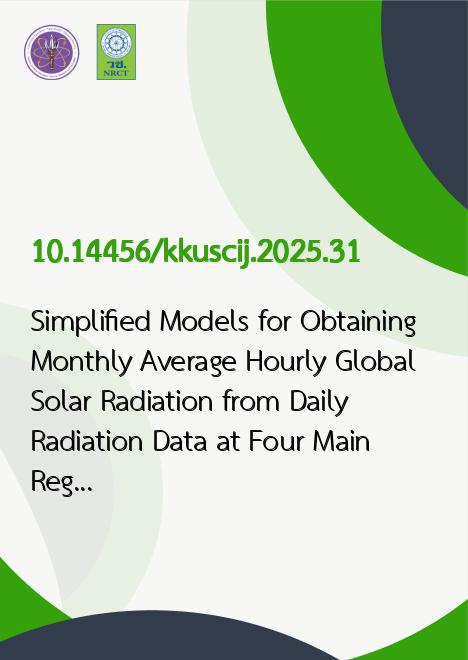
|
Simplified Models for Obtaining Monthly Average Hourly Global Solar Radiation from Daily Radiation Data at Four Main Regions in Thailand |
|---|---|
| รหัสดีโอไอ | |
| Creator | Korntip Tohsing |
| Title | Simplified Models for Obtaining Monthly Average Hourly Global Solar Radiation from Daily Radiation Data at Four Main Regions in Thailand |
| Contributor | Kanokwan Runghathaithum, Serm Janjai |
| Publisher | Faculty of Science, Khon Kaen University |
| Publication Year | 2568 |
| Journal Title | KKU Science Journal |
| Journal Vol. | 53 |
| Journal No. | 3 |
| Page no. | 390-400 |
| Keyword | Collares-Pereira and Rabl Model, Liu and Jordan Model, Global Solar Radiation, Model, Solar Radiation |
| URL Website | https://ph01.tci-thaijo.org/index.php/KKUSciJ |
| Website title | Thai Journal Online (ThaiJO) |
| ISSN | 3027-6667 |
| Abstract | Solar energy has become a significant alternative renewable energy source due to its clean, emission-free, and user-friendly characteristics. However, an efficient utilization of solar energy system requires accurate and reliable solar radiation data, which could not be fulfilled by the ground measurement. Therefore, this study aims to evaluate two simplified models including Collares-Pereira and Rabl (CPR) model and the CPR model combined with Liu and Jordan (CPR-JL) model for estimating a monthly average hourly global solar radiation from monthly average daily global solar radiation, solar geometry, and extraterrestrial solar radiation using the data from four different regions across Thailand, namely Chiang Mai (18.78°N, 98.98°E), Nakhon Pathom (13.82°N, 100.04°E), Ubon Ratchathani (15.25°N, 104.87°E), and Songkhla (7.20°N, 100.60°E) for a period of the year 1995 - 2023. Subsequently, a performance of these models was investigated through statistical indicators such as Root Mean Square Difference, (RMSD), Mean Bias Difference, (MBD), and the coefficient of determination, (R²) using the data of the year 2024. The Results indicated that CPR model provided the best agreement between the measured and calculated monthly average hourly global solar radiation. Thus, this is recommended to apply this model for gathering the hourly average data in other regions, which have similar climate characteristics to the studied locations. |